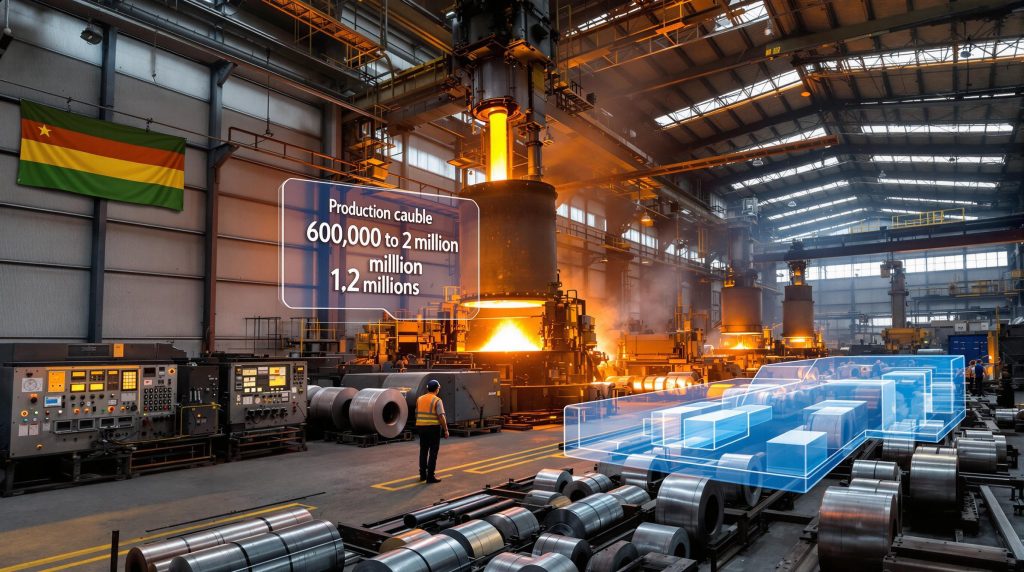Tsingshan's $800 Million Investment in Zimbabwe Steel Plant: Strategic Expansion and Economic Impact
In a significant development for Zimbabwe's industrial sector, Chinese metals giant Tsingshan Holding Group has announced an $800 million investment to expand its Dinson Iron and Steel Company facility. This strategic move not only doubles the plant's production capacity but also positions Zimbabwe to reduce its substantial steel import dependency while creating economic opportunities across multiple sectors.
$800 Million Expansion Plan for Dinson Steel Plant
Tsingshan Holding Group's $800 million investment aims to dramatically increase production capacity at its Dinson Iron and Steel Company facility in central Zimbabwe. The expansion will double the plant's current output from 600,000 metric tons to 1.2 million metric tons of carbon steel annually, representing one of the largest foreign direct investments in Zimbabwe's manufacturing sector in recent years.
The comprehensive investment package includes funding for critical infrastructure development such as centering facilities, rolling mills, steel plants, and a new blast furnace. This significant capital injection demonstrates Tsingshan's long-term commitment to industrial development in Zimbabwe and confidence in the region's growth potential.
Current Operations and Infrastructure
The Dinson steel plant already operates as a substantial industrial presence in Zimbabwe's manufacturing landscape. The facility's first phase included the construction of a 50-megawatt thermal power plant specifically designed to reduce dependency on Zimbabwe's strained national electricity grid—a strategic move considering the country's ongoing power supply challenges.
The plant has implemented innovative energy efficiency measures, including advanced energy recovery systems that capture and utilize furnace gas to generate approximately 20% of its power requirements. This approach not only reduces operational costs but also demonstrates Tsingshan's commitment to mining sustainability trends while mitigating the impact of Zimbabwe's infrastructure limitations.
Why Is This Investment Significant for Zimbabwe?
Reducing Zimbabwe's $1 Billion Steel Import Bill
Zimbabwe currently spends approximately $1 billion annually on steel imports, according to Information Minister Jenfan Muswere. This substantial outflow of foreign currency places significant pressure on the country's already strained financial resources and balance of trade position.
The expansion of domestic steel production capacity through Tsingshan's investment could substantially reduce this import dependency. By producing steel locally, Zimbabwe stands to:
- Conserve valuable foreign currency reserves
- Improve its balance of trade position
- Reduce exposure to international market price volatility
- Create a more self-sufficient industrial base
This import substitution strategy aligns perfectly with Zimbabwe's broader industrial development goals and economic recovery efforts.
Economic Development and Industrial Growth
Steel production serves as a foundational industry that catalyzes growth across multiple sectors of the economy. As a basic material for construction, manufacturing, and infrastructure development, locally produced steel at competitive prices can stimulate activity throughout Zimbabwe's industrial ecosystem.
The expansion project positions Zimbabwe to potentially become a regional steel supplier, opening new export opportunities to neighboring countries that currently rely on imports from more distant sources. This export potential represents a valuable source of foreign currency earnings for Zimbabwe's economy while establishing the country as a manufacturing hub within southern Africa.
Employment and Skills Development
Steel manufacturing facilities typically generate substantial employment opportunities across various skill levels, from technical specialists to production line workers. While specific employment figures for the Dinson expansion have not been disclosed, steel plants traditionally create significant direct and indirect job opportunities.
Beyond direct employment, the expanded operation will support jobs throughout the supply chain, including:
- Raw material suppliers and processors
- Transportation and logistics services
- Maintenance and equipment service providers
- Quality control and testing services
The technical nature of steel production facilitates valuable skills transfer and workforce development in advanced manufacturing processes. These specialized skills have positive spillover effects for Zimbabwe's broader industrial development and create a more technically proficient workforce.
How Does This Fit Into Tsingshan's African Strategy?
Tsingshan's Diversified Zimbabwe Portfolio
Tsingshan's investment in steel production represents just one component of the company's diversified resource portfolio in Zimbabwe. The Chinese conglomerate has established significant operations across multiple strategic minerals and metals in the country, including:
- Ferrochrome production facilities
- Coking coal mining operations
- Lithium extraction projects
This multi-mineral approach demonstrates Tsingshan's comprehensive strategy to secure access to critical minerals strategy while developing value-added processing capabilities in Africa. By operating across multiple resource segments, Tsingshan creates operational synergies while mitigating risks associated with market fluctuations in any single commodity.
Vertical Integration and Supply Chain Control
The expansion of steel production capabilities complements Tsingshan's existing operations in Zimbabwe and across Africa. As one of the world's leading nickel producers, Tsingshan has developed expertise in metals processing that transfers effectively to steel production.
By controlling multiple stages of the metals value chain—from raw material extraction to finished steel products—Tsingshan can:
- Optimize operational efficiency through integrated processes
- Reduce costs by minimizing transportation and third-party processing
- Mitigate supply chain risks through direct control of key inputs
- Capture value at multiple stages of production
This vertical integration strategy has been a hallmark of Tsingshan's global expansion approach and contributes to the company's competitive position in international metals markets.
China's Resource Security Strategy in Africa
Tsingshan's investments align with China's broader strategy of securing access to critical minerals and metals through direct investment in resource-rich African nations. As manufacturing demands continue to grow in China and globally, securing reliable access to essential industrial inputs has become increasingly important for Chinese industrial groups.
Zimbabwe's mineral wealth makes it a strategically important partner in this resource security approach. The country possesses significant deposits of minerals essential to modern manufacturing and energy transition technologies, creating natural synergies with China's industrial development priorities and iron ore trends.
What Challenges Does the Project Face?
Market Demand Uncertainties
Despite committing substantial capital to the expansion, Tsingshan is proceeding cautiously regarding implementation timelines. Project director Wilfred Motsi emphasized that the company will carefully assess market conditions before fully activating the expanded capacity.
"We are ready for the next stage, but we will look closely at market conditions before committing. We need to be sure the market can take that much product," Motsi stated during a recent media tour of the facility.
This measured approach reflects legitimate concerns about:
- Regional steel demand stability
- Competition from established producers
- Economic growth rates in target markets
- Construction and infrastructure development activity levels
The phased implementation strategy allows Tsingshan to align capacity expansion with actual market demand, minimizing the risk of underutilized production capacity.
Infrastructure and Energy Constraints
Zimbabwe continues to face significant infrastructure challenges, particularly regarding reliable electricity supply. While the Dinson plant has implemented measures to reduce grid dependency through its own power generation capabilities, the expanded operations will require substantial additional energy resources.
The country's aging power infrastructure and frequent supply disruptions present ongoing operational challenges for energy-intensive industries like steel production. Even with the plant's 50-megawatt thermal power plant and energy recovery systems, securing reliable and affordable energy remains a critical concern for the expansion project's success.
Additional infrastructure challenges include:
- Transportation networks for raw materials and finished products
- Water supply for industrial processes
- Telecommunications infrastructure for operational management
- Maintenance and technical service availability
Addressing these infrastructure constraints will be essential for the expanded facility to achieve its full production potential and operational efficiency targets.
Regional Competition in Steel Markets
The expanded Dinson facility will face competition from established steel producers in the region, particularly South Africa's large-scale operations. South Africa has traditionally dominated steel production in southern Africa, with established producers benefiting from economies of scale, sophisticated distribution networks, and longstanding customer relationships.
Successfully penetrating regional markets will require the Dinson facility to develop:
- Competitive pricing structures
- Consistent product quality meeting international standards
- Reliable delivery capabilities
- Customer service and technical support functions
- Product customization capabilities for specific market segments
The plant's ability to achieve production efficiencies and control costs will be crucial to its commercial success in competitive steel markets where price sensitivity remains high among industrial customers.
How Will This Impact Zimbabwe's Industrial Development?
Strengthening Domestic Manufacturing Capabilities
Access to locally produced steel at competitive prices could stimulate growth across Zimbabwe's manufacturing sector. Industries ranging from automotive components to agricultural equipment and construction materials stand to benefit from reliable domestic steel supplies with potentially lower transportation costs and shorter lead times.
Local steel production creates opportunities for:
- Development of steel fabrication industries
- Growth in construction materials manufacturing
- Expansion of metal components production
- Revitalization of heavy machinery manufacturing
These downstream manufacturing activities typically generate higher value-added products and create additional employment opportunities while further reducing import dependency across multiple industrial segments.
Infrastructure Development Support
Zimbabwe faces significant infrastructure development needs across transportation, energy, water, and urban development sectors. Domestic steel production directly supports these infrastructure projects by providing essential construction materials at potentially lower costs than imported alternatives.
Key infrastructure projects that could benefit include:
- Road and bridge construction
- Railway network rehabilitation
- Power generation facilities
- Water treatment and distribution systems
- Commercial and residential construction
This synergy between steel production and infrastructure development creates a virtuous cycle of industrial growth and economic development. As infrastructure improves, economic activity increases, generating further demand for steel and other construction materials.
Technology Transfer and Industrial Modernization
The introduction of advanced steel production technologies through Tsingshan's investment contributes to Zimbabwe's industrial modernization efforts. Modern steel production facilities incorporate sophisticated process control systems, quality management protocols, and efficiency optimization technologies that represent valuable knowledge transfers to the local industrial sector.
The transfer of technical expertise, production methodologies, and quality control systems can have spillover effects across related industries, elevating overall manufacturing capabilities and standards in the country. This technological upgrading effect extends beyond the direct steel industry to include:
- Materials testing and quality control practices
- Industrial maintenance and reliability engineering
- Process optimization and efficiency techniques
- Environmental management systems
- Industrial safety protocols
These knowledge transfers contribute to broader industrial capability development that benefits Zimbabwe's manufacturing sector as a whole.
What Are the Environmental Considerations?
Energy Efficiency Innovations
The Dinson facility has incorporated energy efficiency measures including waste heat recovery and furnace gas utilization. These technologies reduce the plant's environmental footprint while improving operational economics. The expansion project presents opportunities to implement additional electrification and decarbonisation measures aligned with evolving global standards for metals production.
Modern steel production increasingly emphasizes energy efficiency through technologies such as:
- Continuous casting processes that reduce reheating requirements
- Heat recovery systems that capture waste energy
- Variable speed drives on motors and pumps
- Advanced combustion control systems
- Process integration to minimize energy transfer losses
These efficiency measures not only reduce environmental impact but also improve cost competitiveness in an industry where energy represents a significant portion of production costs.
Environmental Management Challenges
Steel production inherently involves significant environmental considerations including air emissions, water usage, and waste management. The expanded operations will need to implement robust environmental management systems to mitigate potential impacts on surrounding communities and ecosystems.
Key environmental management priorities include:
- Particulate matter and dust control
- Sulfur dioxide and nitrogen oxide emissions management
- Wastewater treatment and recycling
- Solid waste management and byproduct utilization
- Noise pollution control
Adherence to international environmental standards will be essential for sustainable operations and maintaining community support for the expanded industrial activity. Modern steel plants increasingly implement comprehensive environmental management systems with continuous monitoring and performance improvement protocols.
Carbon Footprint and Climate Considerations
As global attention to carbon emissions intensifies, steel producers face increasing pressure to reduce their climate impact. The expansion project provides an opportunity to incorporate lower-carbon production technologies and processes that align with global decarbonization trends.
Options for reducing carbon intensity include:
- Increased scrap metal utilization in production processes
- Optimization of reduction processes to minimize coal and coke usage
- Carbon capture utilization and storage technologies
- Hydrogen utilization in reduction processes (longer-term potential)
- Renewable energy integration for power needs
Tsingshan's approach to addressing these climate considerations will influence the long-term sustainability of the operation in an increasingly carbon-conscious global market where customers and investors increasingly prioritize environmental performance.
FAQs About Tsingshan's Zimbabwe Steel Investment
When will the expanded production capacity be fully operational?
The timeline for full implementation of the expanded capacity remains flexible, contingent upon market conditions. Tsingshan has indicated it will phase the expansion based on careful assessment of demand for carbon steel products in regional markets. Project director Wilfred Motsi has emphasized that market readiness will determine the activation timeline for the full production capacity.
How does this investment compare to other Chinese investments in African steel?
This $800 million commitment represents one of the larger Chinese investments in African steel production, though it follows a pattern of Chinese metals companies establishing processing facilities closer to African raw material sources. Similar investments have been made in countries including Ethiopia, Kenya, and Tanzania, reflecting China's strategy of developing resource processing capabilities throughout the continent, according to Mining Technology.
What types of steel products will the expanded facility produce?
The Dinson plant focuses on carbon steel production, which encompasses a wide range of construction and industrial steel products. The specific product mix for the expanded facility will likely include:
- Structural steel shapes for construction
- Reinforcing bars for concrete structures
- Wire rod for various industrial applications
- Flat products for manufacturing and fabrication
- Specialized steel profiles for specific industrial applications
The exact product mix will likely evolve based on market demand patterns and profitability considerations, with the potential to expand into higher-value specialized products as the operation matures.
How will this affect steel prices in Zimbabwe and neighboring countries?
Increased domestic production typically leads to more competitive pricing through reduced transportation costs and import duties. Consumers of steel products in Zimbabwe and potentially neighboring countries could benefit from:
- More stable supply availability
- Reduced delivery lead times
- Lower transportation cost components
- Elimination of import duties for domestic users
- Potential currency advantages compared to imported products
The actual price impact will depend on Tsingshan's pricing strategy, production efficiency achievements, and regional market dynamics including competition from established producers in neighboring countries.
Sustainable Development Through Strategic Industrialization
The Tsingshan investment represents more than just a commercial steel production facility—it embodies Zimbabwe's aspirations for industrial revitalization through strategic partnerships and value-added processing of natural resources. By transforming raw materials into finished steel products domestically, Zimbabwe captures significantly more economic value while developing technical capabilities essential for broader industrial development.
For Tsingshan, the investment extends its vertical integration strategy while securing access to critical resources in a region of growing strategic importance. The cautious, market-driven implementation approach demonstrates the company's commitment to sustainable business development rather than speculative capacity expansion.
As the project moves forward, balancing economic development objectives with environmental stewardship and community engagement will be essential for long-term success. Modern industrial development increasingly requires this holistic approach that considers not just financial returns but broader sustainability impacts across environmental and social dimensions, as highlighted in an LSE Africa report.
For Zimbabwe, the challenge will be leveraging this significant investment opportunities insights to catalyze broader industrial development through complementary policies, infrastructure improvements, and workforce development initiatives that maximize the economic benefits beyond the direct operations of the Tsingshan to invest in Zimbabwe steel plant itself.
Are You Investing in ASX Mining and Exploration Companies?
Discover the next major mineral opportunity before the market with Discovery Alert's proprietary Discovery IQ model, which delivers real-time alerts on significant ASX mineral discoveries like recent African resource developments. Explore historic discoveries and their remarkable returns on our dedicated discoveries page and position yourself ahead of the market.




